SAS Bundle
Can SAS Still Dominate the Analytics Arena?
The analytics software industry is a battlefield of innovation, where staying ahead demands constant adaptation. SAS, a veteran of this arena since 1976, has consistently evolved to meet the changing needs of businesses worldwide. From its roots in statistical analysis to its current focus on AI and cloud solutions, SAS has built a formidable reputation.
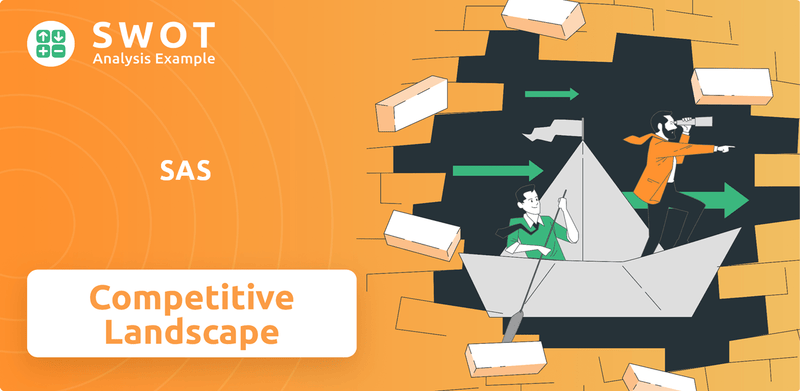
As businesses increasingly rely on data-driven decisions, understanding the SAS SWOT Analysis and its position within the SAS competitive landscape is critical. This exploration will provide a deep dive into SAS competitors, offering a comprehensive SAS market analysis to understand its strategies and competitive advantages within the SAS business intelligence and SAS analytics market. We'll examine the SAS platform and its standing against SAS software competitors to provide valuable insights.
Where Does SAS’ Stand in the Current Market?
SAS is a significant player in the analytics software sector, known for its advanced analytics solutions. The company's core operations revolve around providing comprehensive data management, business intelligence, and advanced analytics, including predictive analytics and machine learning capabilities. Their flagship cloud-native platform, SAS Viya, is central to their offerings, designed to accelerate the data and AI lifecycle for clients across various industries.
The value proposition of SAS lies in its ability to transform raw data into actionable insights, helping businesses make better decisions. This is achieved through a suite of tools that cover the entire analytics spectrum, from data preparation to advanced modeling and deployment. With a focus on innovation and customer success, SAS aims to empower organizations to solve complex business problems and drive better outcomes.
In 2025, SAS Analytics held a 5.11% market share in the analytics and BI platform market. SAS Business Intelligence had a 0.03% market share in 2025. Historically, SAS has been strong in predictive analytics, holding a 30.8% market share in 2019, significantly ahead of its competitors.
SAS offers a comprehensive suite of analytics solutions, including data management, business intelligence, and advanced analytics. Their primary product is SAS Viya, a cloud-native platform. The company also provides services such as consulting, training, and technical support to help customers maximize the value of their software investments.
SAS has a global presence, with offices and customers in over 140 countries. They serve a diverse customer base across industries like finance, healthcare, retail, and government. In 2024, SAS continued to expand its data and AI solutions for life sciences and healthcare, working with over 2,900 customers in these sectors.
SAS has shifted from a vertical marketing focus to a horizontal approach, leveraging its partner network. This strategy includes a strong emphasis on cloud adoption, with Viya available on Microsoft Azure and AWS, and planned availability on Google Cloud Platform. This move aims to provide platform flexibility and address consumption-based pricing.
SAS is a privately held, profitable company with no debt. In 2023, SAS achieved an 8% revenue growth, with revenues of approximately $3.5 billion. This financial health and consistent profitability, particularly its strong cloud growth, indicates a robust standing. To understand more about their business model, you can read about the Revenue Streams & Business Model of SAS.
- SAS has a strong market position in the analytics software industry.
- SAS Viya sales grew by 24% in 2024, with Viya 4 sales increasing by 56%.
- SAS Managed Cloud Services sales grew by 16% in 2024.
- SAS holds a strong position in industries like banking, government, insurance, and healthcare.
SAS SWOT Analysis
- Complete SWOT Breakdown
- Fully Customizable
- Editable in Excel & Word
- Professional Formatting
- Investor-Ready Format
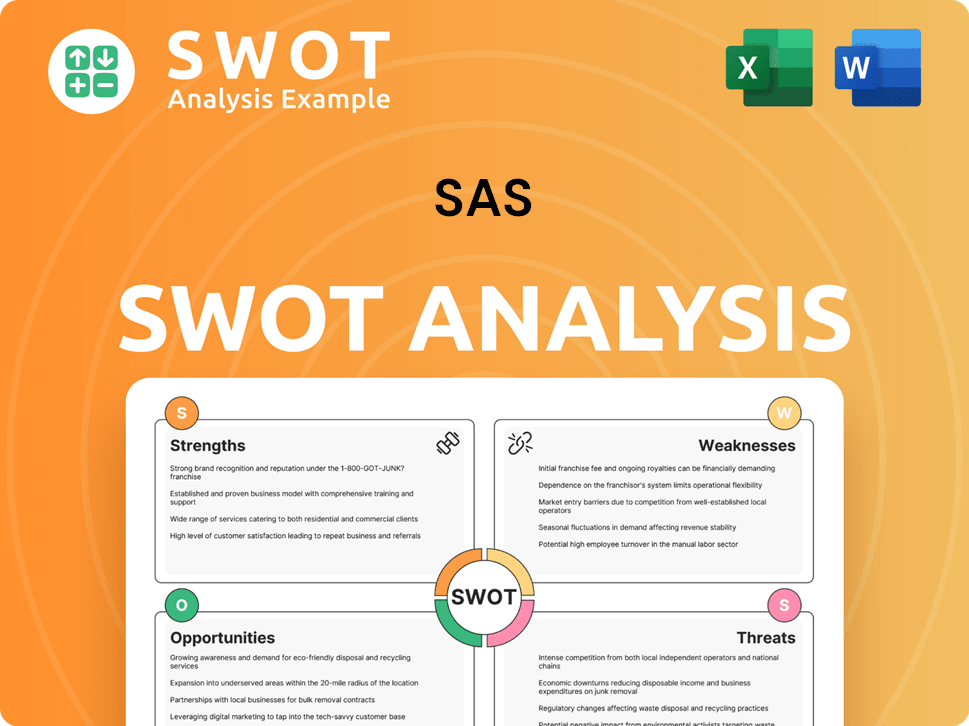
Who Are the Main Competitors Challenging SAS?
The competitive landscape for SAS in the analytics and business intelligence (BI) software market is dynamic, with a diverse range of competitors vying for market share. Understanding the key players and their strategies is crucial for assessing SAS's position and future prospects. This analysis provides an overview of SAS's main rivals, their competitive advantages, and the challenges SAS faces.
SAS's ability to maintain its market position depends on its capacity to innovate, adapt to changing market dynamics, and effectively compete with both established and emerging players. The competitive environment is influenced by technological advancements, evolving customer preferences, and the emergence of new business models, making it essential to continuously monitor and analyze the competitive landscape.
The Target Market of SAS includes a wide range of industries and business sizes, but the competitive landscape is complex. SAS faces significant competition from both direct and indirect rivals in the analytics and business intelligence software market. Its key competitors include major technology companies such as IBM, Microsoft, and Oracle. Other prominent competitors in the analytics and BI platform category include Mixpanel (with 44.93% market share), SAP Business Objects (16.36% market share), and Qlik Sense (8.44% market share).
SAS faces competition from major tech companies, including IBM, Microsoft, and Oracle. Smaller, specialized firms like Mixpanel and Qlik Sense also compete in the analytics and BI platform category.
Google Analytics holds a substantial market share of 91.08% in the broader analytics space. This highlights the dominance of certain platforms, even if they target different user segments than SAS.
Alternatives to SAS Visual Analytics include Tableau, Spotfire, Alteryx, and Looker. These platforms offer different strengths in data visualization and ease of use.
Competitors challenge SAS through innovation, pricing models, market share shifts, and diversified offerings. The rise of cloud computing and AI also influences competition.
Microsoft (with Power BI) and Tableau are known for user-friendly interfaces and strong data visualization. Advancements in AI and machine learning are also major drivers of competition.
The shift towards cloud computing and consumption-based pricing models, as offered by hyperscalers like Microsoft Azure and AWS, presents a challenge to traditional licensing models.
The competitive landscape is constantly evolving due to the rise of big data, AI, and cloud computing. SAS must adapt to these changes to maintain its market position.
- Emerging players focusing on AI applications and synthetic data pose a challenge.
- Mergers and alliances shape competitive dynamics, influencing market share.
- SAS is increasing its partnerships to support global sales and integrate its solutions.
- Partnerships, such as with Experian, allow SAS solutions to be embedded in other ecosystems.
SAS PESTLE Analysis
- Covers All 6 PESTLE Categories
- No Research Needed – Save Hours of Work
- Built by Experts, Trusted by Consultants
- Instant Download, Ready to Use
- 100% Editable, Fully Customizable
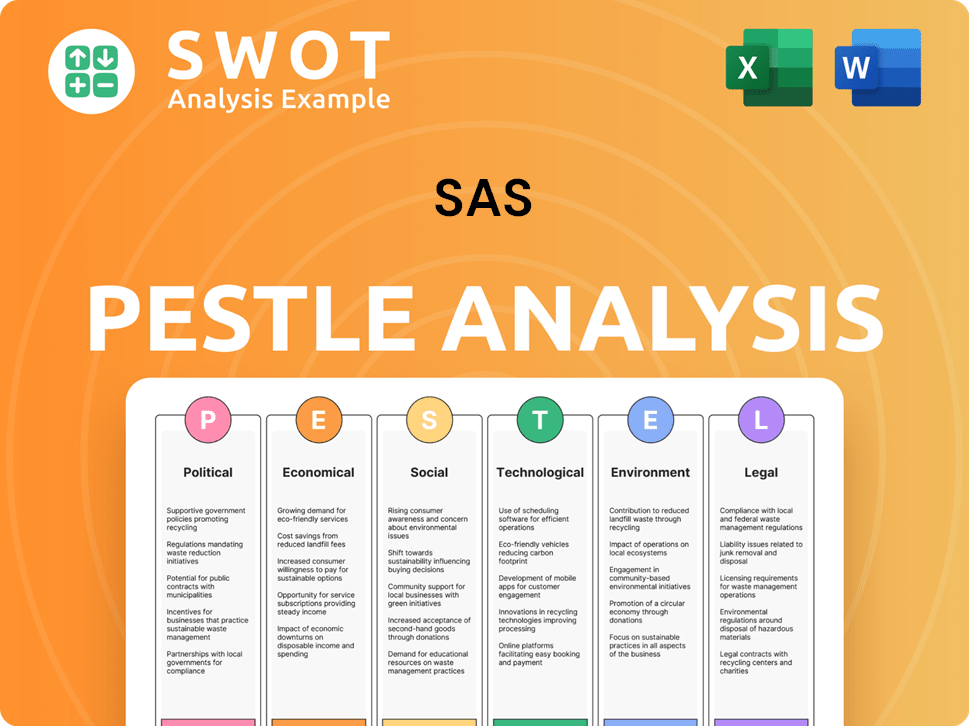
What Gives SAS a Competitive Edge Over Its Rivals?
The competitive landscape for SAS is defined by its robust technological foundation, extensive industry expertise, and strong customer relationships. SAS has consistently invested in research and development, leading to a comprehensive suite of analytics solutions. Strategic moves, such as the acquisition of Hazy in November 2024, demonstrate its commitment to expanding capabilities and addressing evolving market needs. These initiatives are crucial for maintaining its competitive edge in a dynamic market.
SAS's competitive advantages are multifaceted, including its advanced technology, industry-specific solutions, and a loyal customer base. The company's focus on customer support and training, coupled with its proprietary technologies, sets it apart from competitors. SAS's global presence and strategic partnerships further enhance its market position, allowing it to adapt to global trends and expand its reach.
The company's evolution towards cloud-native offerings and AI integration, particularly with SAS Viya, is a key strategic direction. This shift, along with its focus on productivity and efficiency, underscores SAS's commitment to innovation and customer value. By emphasizing these strengths, SAS aims to maintain its leadership in the business analytics market, even as it navigates the challenges posed by open-source alternatives and cloud-native competitors. A thorough SAS competitive landscape analysis is essential for understanding its position.
SAS is recognized for its cutting-edge technology and comprehensive solutions in business analytics. The company offers a broad range of software and services, from data management to predictive analytics and machine learning. The flagship SAS Viya platform is designed to accelerate the data and AI lifecycle, enhancing its market position.
With decades of experience, SAS has developed deep domain expertise across various sectors, including finance, healthcare, and retail. This allows SAS to tailor its solutions to meet the specific needs of different industries. This industry-specific approach provides a significant competitive edge, making SAS a preferred choice for many organizations.
SAS has a strong reputation for excellent customer support and training programs. This focus on customer success helps deepen relationships and drive loyalty. These services ensure that customers have the resources and knowledge needed to succeed with the software. This customer-centric approach is a key differentiator.
SAS possesses over 700 patents, indicating a strong foundation in proprietary technologies. Its software suite, including Base SAS, provides an intuitive 4GL with easy-to-learn syntax. SAS Viya has been shown to offer significant productivity advantages, with data engineers being 16 times more productive than competing solutions.
Studies have shown that SAS Viya helps users execute the lifecycle of collecting data, building models, and deploying decisions 4.6 times faster than selected competitors. This leads to increased innovation and faster decision-making. This efficiency is a key selling point, particularly for enterprises with substantial data needs, and is a crucial aspect of SAS competitive advantages.
- SAS Viya's speed and efficiency are significant differentiators.
- The platform's performance contributes to faster time-to-market.
- Increased productivity leads to revenue growth.
- SAS's focus on efficiency is a key element of its competitive strategy.
SAS Business Model Canvas
- Complete 9-Block Business Model Canvas
- Effortlessly Communicate Your Business Strategy
- Investor-Ready BMC Format
- 100% Editable and Customizable
- Clear and Structured Layout
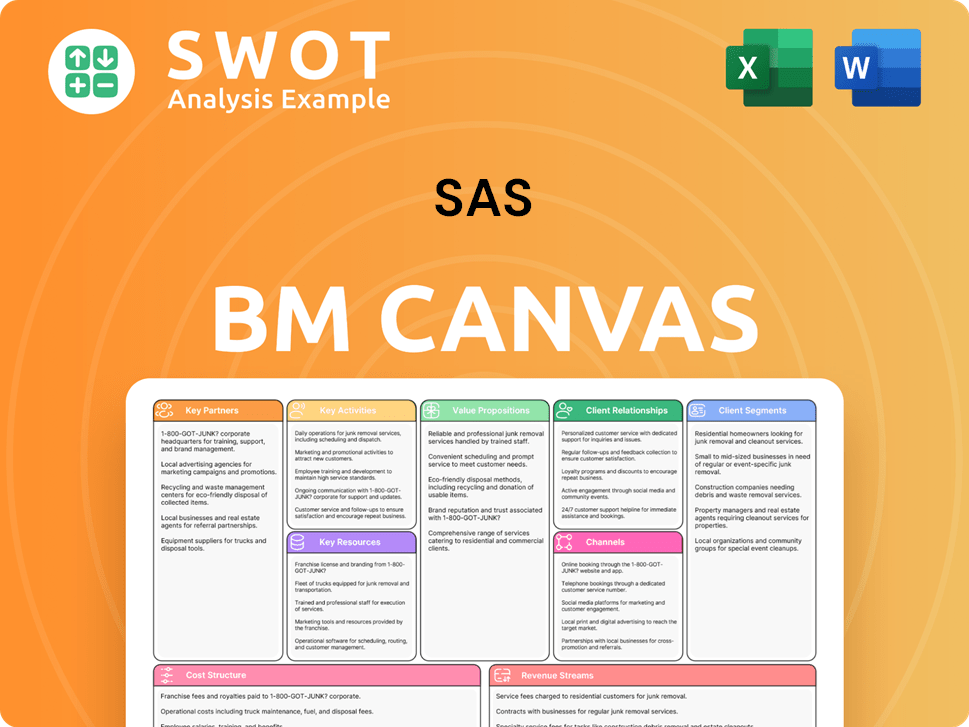
What Industry Trends Are Reshaping SAS’s Competitive Landscape?
The competitive landscape for SAS is shaped by evolving industry trends, technological advancements, and the strategic moves of its competitors. A thorough Growth Strategy of SAS reveals the company's position within the analytics market, the risks it faces, and its future outlook. Understanding these factors is crucial for stakeholders making informed decisions.
The business analytics software market is dynamic, with SAS navigating challenges and opportunities. The following analysis provides insights into the industry trends, potential challenges, and prospects for SAS, offering a comprehensive view of its competitive environment.
Technological advancements, especially in AI and ML, are transforming data analytics. Cloud computing is gaining momentum, offering improved accessibility and cost-efficiency. Edge computing and the Internet of Things (IoT) are also driving the need for real-time data processing and analysis.
Rapid technological advancements require continuous investment in R&D. Increasing competition and data security concerns pose significant challenges. Open-source alternatives like Python and R also present competition, especially among younger data scientists. Modernizing legacy systems is another complex challenge.
Expansion into new markets and industries offers growth potential. Innovation in products, especially in AI and cloud-native offerings like SAS Viya, is key. Strategic partnerships and customer loyalty are also significant opportunities. Addressing emerging needs in healthcare and manufacturing presents growth avenues.
SAS's competitive advantages include its cloud-native Viya platform and AI capabilities. The company focuses on cloud deployment flexibility, market segmentation, and expanding its partner ecosystem. Commitment to AI governance and 'responsible AI' addresses data security and ethical concerns.
The competitive environment for SAS is influenced by industry trends and the company's strategic responses. SAS must navigate rapid technological advancements and increasing competition while ensuring data security and privacy. The shift towards cloud computing and edge computing creates both challenges and opportunities for SAS, with a focus on cloud-native solutions.
- Rapid Technological Advancements: SAS needs to keep up with AI, ML, and quantum computing.
- Increasing Competition: The growing demand for business analytics intensifies competition.
- Data Security and Privacy: Ensuring robust data security and compliance is crucial.
- Open-source Alternatives: Competition from open-source options like Python and R.
- Legacy System Modernization: Addressing older SAS platforms presents a challenge.
SAS Porter's Five Forces Analysis
- Covers All 5 Competitive Forces in Detail
- Structured for Consultants, Students, and Founders
- 100% Editable in Microsoft Word & Excel
- Instant Digital Download – Use Immediately
- Compatible with Mac & PC – Fully Unlocked
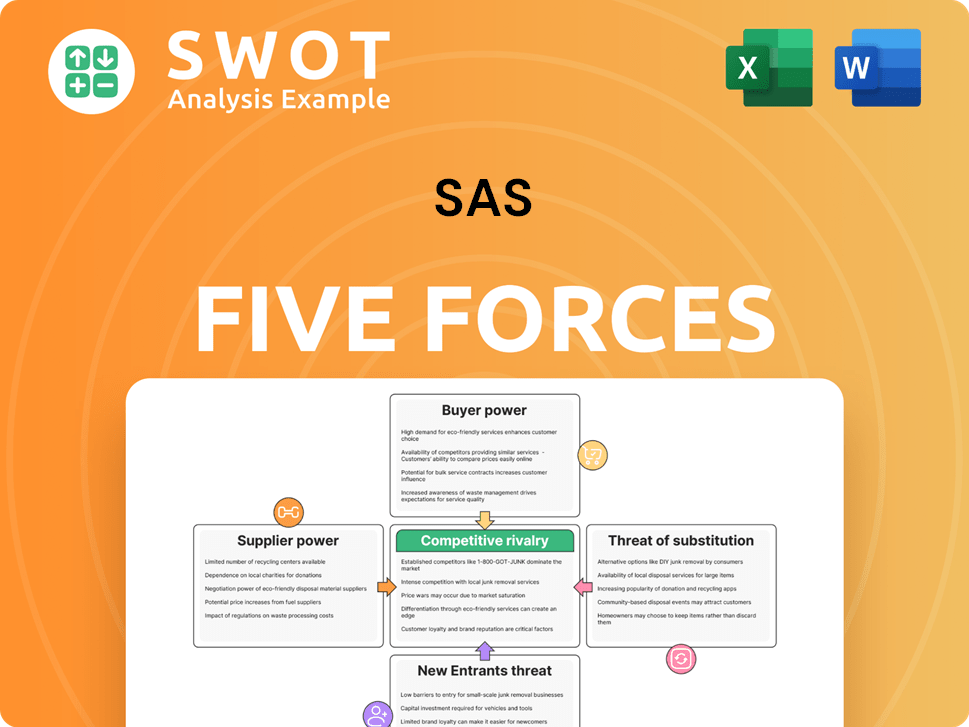
Related Blogs
- What are Mission Vision & Core Values of SAS Company?
- What is Growth Strategy and Future Prospects of SAS Company?
- How Does SAS Company Work?
- What is Sales and Marketing Strategy of SAS Company?
- What is Brief History of SAS Company?
- Who Owns SAS Company?
- What is Customer Demographics and Target Market of SAS Company?
Disclaimer
All information, articles, and product details provided on this website are for general informational and educational purposes only. We do not claim any ownership over, nor do we intend to infringe upon, any trademarks, copyrights, logos, brand names, or other intellectual property mentioned or depicted on this site. Such intellectual property remains the property of its respective owners, and any references here are made solely for identification or informational purposes, without implying any affiliation, endorsement, or partnership.
We make no representations or warranties, express or implied, regarding the accuracy, completeness, or suitability of any content or products presented. Nothing on this website should be construed as legal, tax, investment, financial, medical, or other professional advice. In addition, no part of this site—including articles or product references—constitutes a solicitation, recommendation, endorsement, advertisement, or offer to buy or sell any securities, franchises, or other financial instruments, particularly in jurisdictions where such activity would be unlawful.
All content is of a general nature and may not address the specific circumstances of any individual or entity. It is not a substitute for professional advice or services. Any actions you take based on the information provided here are strictly at your own risk. You accept full responsibility for any decisions or outcomes arising from your use of this website and agree to release us from any liability in connection with your use of, or reliance upon, the content or products found herein.